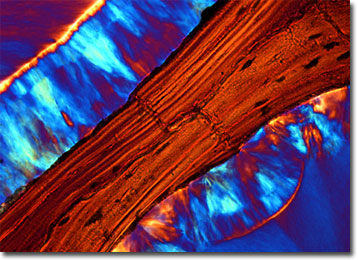Polarized Light Microscopy Digital Image Gallery
Dinosaur Bone
Extinct for approximately 65 million years, it is primarily through the examination of dinosaur bones and other fossils that humans have been able to piece together some understanding of the lives (and deaths) of these fascinating creatures.

Fossils may include the preserved remains or imprints of an organism, such as bones, teeth, footprints, or leaf impressions. To become fossils, these items must undergo some form of mineralization, which involves the replacement of decayed organic matter with silica, calcite, iron, and other minerals. This process can be quite lengthy, many scientists believing that fossilization takes more than 10,000 years to complete. The exact rate of mineralization that takes place, however, depends heavily upon the chemical characteristics of the surrounding environment.
The majority of dinosaur fossils that have been found are bones, but they also include eggshells, tracks, skin imprints, fossilized feces, and stomach stones. The term dinosaur was originally coined in 1842 by British comparative anatomist Richard Owen from the Greek words for “terrible” and “lizard.” This association with reptiles was generated from the early study of fossilized bones and from the understanding that dinosaurs produced their young in the form of hard-shelled eggs. However, many more recent researchers have postulated that dinosaurs are actually ancient ancestors of birds, drastically changing the common perception of these intriguing animals.
